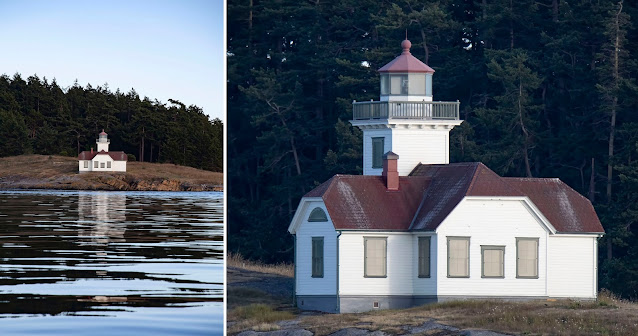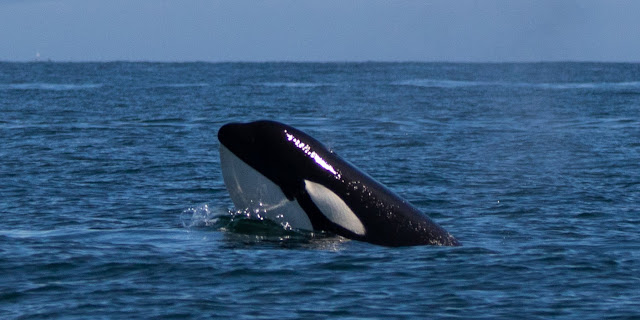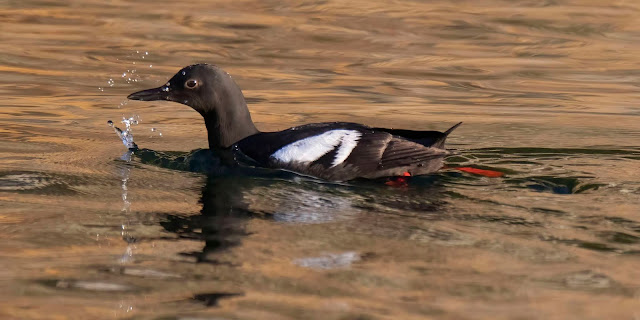 |
| What we were looking for |
While in Friday Harbor in the San Juan Islands, we went on three trips with Maya’s Legacy Whale Watches, a local company that specializes in small-boat tours.
 |
| The boats are small so you can get close |
 |
| Maya's is convenient; it sails right from Friday Harbor |
Our first whale watch was an evening tour the day we arrived.
Remember, this was summer very far north. It doesn't get dark until after 10:00 p.m.
A great trip, but we didn’t see any Orcas!
Was the Caty curse going to continue?
 |
| Whatever ... |
It was a lovely cruise where we saw several Bald Eagles, including a nest occupied by an Eaglet and guarded by one of the parents …
 |
| The San Juans have at least 125 pairs of nesting Bald Eagles |
… a very regal Juvenile Bald Eagle …
 |
| Eagles are everywhere in the San Juan Islands |
... and another adult that flew to a tree ...
 |
| Bald Eagle in flight |
... and treated us to song (if you can call an Eagle’s screams a song) …
We saw Steller Sea Lions, starting with a group posing on a buoy. It’s a bit of a cliched look, but this is how you often see Sea Lions.
 |
| Just chillin' |
And, in this case, the late afternoon light was spectacular …
 |
| Showing us his best side and his heart-shaped scar |
… for the Glaucous-winged Gull, too ...
 |
| Each buoy gets a gull finial |
Later, we saw some flocks Rhinoceros Auklets and I got one quick shot of one on the water with a mouth full of fish before it dove for more fish.
 |
| Iconic Auklet looks: flying and fishing |
We saw Black Oystercatchers …
 |
| One of three types of Oystercatcher I have seen: Black, American and Eurasian |
We saw lots of Black Guillemots …
… with their adorable red feet …
 |
| They also have bright red inside their mouths, but I never saw one open its mouth |
In fact, it was these birds that won the day …
 |
| It was sunset; I like this dark look |
They are very photogenic …
 |
| Photogenic, but sometimes a bit goofy |
… and I got lots …
 |
| They have to "walk" across the water to lift off |
… and lots …
 |
| Finally airborne |
... and lots ...
 |
| This kind of fishing is called "dabbling" |
… of good shots …
 |
| The lovely Black Guillemot |
… surrounded by some in the water …
 |
| Harbor Seals are found north of the equator in both the Atlantic and Pacific |
... and a few more that looked as though they were levitating ...
 |
| A roly-poly little guy |
... they lifted their tails and appeared to smile every time a wave crashed on them …
 |
| They favor coastal waters, rocky islands, sandy beaches, mudflats, bays and estuaries |
The way they were posed, they reminded me of the tableau that ballerinas form ...
 |
| Look at those faces! |
Out on the water, we had lovely views of the Patos Island Lighthouse, both as we were heading out …
 |
| A cute little lighthouse |
… and coming back …
 |
| A spectacular backdrop |
And, in the far distance we could see 10,778-foot-tall Mount Baker on the mainland (and before you think that’s not so tall compared to our 14ers, remember that that almost 11,000 feet is rising from sea level) …
 |
| You are seeing more mountain than 14ers in Colorado |
It was a beautiful evening with some spectacular wildlife. But, no Orcas.
We were concerned, but decided to keep a positive attitude. Tomorrow was another day!
Early the next morning, we were at Maya’s waiting for our half-day whale watching trip. Sure, we hadn’t seen any the night before, but we were confident.
The boat is a small one with covered seats in the middle, an open back deck and a small amount of seating a viewing area on the bow.
There were windows in the covered area, which the crew would flip open if we were stopped to view something.
The first night, Caty and I had spent almost all the trip on the back deck. I do not like to be inside, ever, even if the windows can be opened.
 |
| Sara, our naturalist |
This time, Caty and I decided to sit on the bow, which afforded better 180+ degree visibility. From the night before, we knew that the ride should be fairly smooth.
The first night, we had headed north. This time, we were moving south. As we approached a nice view of a lighthouse, I assumed that the captain would turn toward the lighthouse to give us good photo ops.
But, he didn’t. He sped up and passed the lighthouse. It was a somewhat harrowing ride with back-jarring slams into swells as we held on for dear life. He must have gotten a radio report of Orcas.
And, indeed he had. We saw them at a distance, in the midst of some pretty spectacular activity …
Then, we moved closer among other whale watching boats – some from the San Juans, some from Port Townsend on the Olympic Peninsula and one other Maya’s boat (it was an all-day tour that was sold out when we tried to book).
 |
| Everyone got a great view |
What transpired after that was a jumble of activity. I am not posting these photos in any particular order; that would be just too difficult to recall.
There were at least six, probably seven Orcas. And, they were active.
 |
| No one knows why they do this; probably trying to attract the boys |
Sometimes solo …
 |
| Twisting and slapping |
Sometimes in tandem …
 |
| A male and a female |
There was one really nice roll-over …
 |
| A nice view of the underside of an Orca |
We saw several breaches and some semi-spy-hopping. I managed to get only these two blurry photos of that activity ...
 |
| My worst best photos |
Caty did better ...
 |
| Orca breach; Photo: Caty Stevens |
And, I even told Caty to expect breaches after a deep dive and I missed it! She got it, though.
 |
| Coming out of the water; Photo: Caty Stevens |
I had to pull back on my 600mm lens because it was so hard to keep the fairly close whale in my focal area.
 |
| They were close and very active |
The Orcas included a number of females, identifiable by relatively small dorsal fins ..
… and two males, obvious because of their tall dorsal fins …
But, the naturalist knew more about the two guys than just their sex. Orcas can be positively identified – and thus, tracked – by markings on their saddlepatch (the white area over the back), eyepatch, tails and fins and by scars.
 |
| Ted's mark |
Each known whale is given a number to help tracking. These were brothers from Alaska, who traveled together, frequently coming to the San Juans for a variety of excellent adventures. T128, born in 1988, was affectionately known as “Bill” and his baby brother, T125A, was born in 1998 and is known as “Ted.”
Ted is very distinctive, with a huge dorsal fin that has a sizeable chunk -- perhaps a bite -- out of it.
It was such a fun time, watching this group cavort.
Success for Caty. The Orca curse is over.
 |
| Ted approves! |
With all the whale watching, we didn’t have time for much of anything else. But, we did see some equally rambunctious sea lions. They were barking…
... rough housing ...
 |
| These were play-fighting, so there was no real damage |
... and splashing ...
 |
| Into the water after the tussle |
Plus, some were just watching us from a small rock island …
 |
| Minutes later, the lower one dove in |
We also saw a Double-crested Cormorant rookery …
 |
| This was mainly Double-crested with a few Pelagics mixed in |
A Bald Eagle keeping watch on a channel marker near the harbor ...
 |
| Guarding the harbor |
And, oh, the scenery …
 |
| A view of Mount Baker enhanced by an Orca |
Whale Watch #3
A brief break and we were off again, for our final whale watch – a repeat of the evening tour we had done the night before. And, unlike our morning trip, we headed north because there had been some reports of Orca activity in that direction.
It was Bill and Ted again! Thirty-five miles north of where we had seen them just hours earlier!
 |
| There's that missing chunk again |
That illustrates how quickly these animals can swim!
 |
| T128 and T125A from Alaska |
These boys do like their adventures …
 |
| Bill taking a breath |
This time there were no ladies. That may have been why Bill and Ted were much more subdued, just generally swimming about.
And, while they were not as entertaining, they were much, much closer.
 |
| Surfacing right by the boat |
It very exciting for Caty, who finally got to see her Orcas …
After a great show, we had to head back, stopping briefly for views of Cattle Point Lighthouse, which is on San Juan Island ...
 |
| Cattle Point Lighthouse |
 |
| Female Harlequin Duck |
We saw Steller Sea Lions on an area called Whale Rocks …
 |
| Watching us as we watched them |
... a hauled out group of Harbor Seals ...
 |
| Catching the last rays of the day |
... a Bald Eagle ...
 |
| Is he judging us? I think he is judging us |
… and a final treat, which I had asked the captain to find after my one poor shot of the first whale watch: a Rhinoceros Auklet with a mouth full of fish …
 |
| Such a cool shot |
They are called “Rhinoceros” because during breeding season they have a short spike at the base of their bills.
 |
| You can see the spike here |
It was a lovely evening.
 |
| A Sea Lion enjoying a beautiful summer evening |
Another success!
San Juans, I love you!
About Orcas
I have blogged about Orcas before, but here are some facts (edited for length) from Oceana, a charitable group that protects the world’s sea life:
Orcas get their nickname "Killer Whales" from their reputation of being ferocious predators.
They are actually very large dolphins, reaching lengths of 33 feet and weights of at least 22,000 pounds.
 |
| San Juan Islands, 2021 |
 |
| San Juan Islands, 2012 |
They generally live in small groups and organize complex group behaviors when mating and hunting.
 |
| Alaska, 2018 |
Orcas are the most widely distributed cetaceans (Whales, Dolphins and Porpoises) and can be found in every ocean.
 |
| San Juan Islands, 2021 |
 |
| Alaska, 2008 |
Orcas pass down specific communication and hunting skills to younger members, distinguishing one pod's culture from another.
 |
| Alaska, 2018 |
Although all Orcas, worldwide, are considered to be members of the same species, recent research suggests, based on appearance, habitat and diet, there may be as many as 16 different species.
 |
| Alaska, 2018 |
Orcas have never been known to attack humans in the wild, but captive Orcas have killed several trainers, most likely from the stress of being confined in small, inadequate spaces.
 |
| San Juan Islands, 2021 |
In the U.S. and some other places, Orcas are given complete legal protection.
 |
| San Juan Islands, 2021 |
Many Orcas live in the San Juans year-round and some migrate to the from Alaska, including Bill and Ted.
Orcas tend to “arrange” themselves by their diet, seldom, if ever, changing what the eat.
 |
| Alaska, 2018 |
There used to be a fair number of Orcas in the Northwest that ate exclusively salmon, but, with a precipitous decline in salmon, these pods have all but disappeared. Now, most of the Orcas eat Sea Lions and Seals. Those pods are doing quite well.
In the past, Orcas have been defined as “resident” or “transient,” but those labels aren’t entirely accurate because some “resident” Orcas move about and some “transients” stay put. I’m going to let the naturalists clarify their designations before I even try to define Orcas.
 |
| San Juan Islands, 2021 |
The Ferry Back
The next morning, we returned to the mainland via the ferry.
 |
| The Washington State Ferry |
This was our final maritime experience of this trip. It was a beautiful ride, punctuated by some Rhinoceros Auklet sightings …
One Harbor Seal …
 |
| He swam with us for awhile |
And, some beautiful scenery.
 |
| Mount Baker from the ferry channel |
A successful visit.































No comments:
Post a Comment